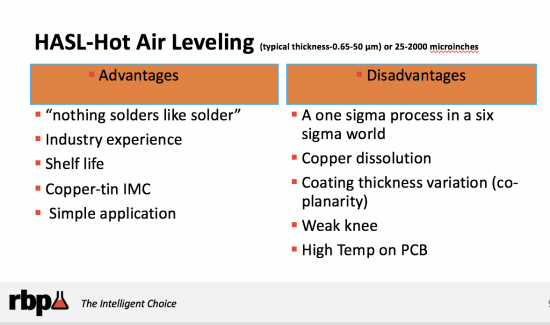Advantages and Disadvantages of Hot Air Leveling
Let’s talk about hot air leveling, and of course, lead-free hot air leveling. If you’ve spent time in Asia and Europe, you’ll notice that in North America, the final finish market is still significantly different than it is in Asia and in Europe. Particularly in Asia, where they have moved away significantly from hot air leveling. Less than three percent of circuit boards made in Asia now use hot air solder leveling, or even lead-free hot air solder leveling. Whereas in North America, we’re still seeing a good portion, 35 to 40 percent of the circuit boards, using some type of hot air leveling, whether it be lead-free or lead based. Why is that? Hot air leveling has many advantages and disadvantages. Below we will highlight some of these advantages and disadvantages.
Advantages of Hot Air Leveling
There’s an old saying that “nothing solders like solder.” One advantage of hot air leveling is that it has been the industry standard for years. There is also a lot of industry experience to rely on if you decide to use a hot air solder leveling on your circuit boards. Another advantage to hot air solder leveling is the ease of the process. The application is simple, so even those who are newer to printed circuit board fabrication can do it. Lastly, circuit boards that use hot air leveling have a longer shelf life, making it a key reason it is still used in circuit board fabrication.
Disadvantages of Hot Air Leveling
There are significant disadvantages to hot air leveling. We call hot air leveling a one sigma process in a six sigma world. You do not get the uniform thickness of the hot air level solder across your panel as you would with other finishes that are plated on. There is also a concern about high temperature on the printed circuit board. Anytime you subject a printed circuit board or print circuit board assembly to significant heat excursions, you can cause that board to feel fatigue and stress. Stress eventually takes its toll on the reliability of the the circuit board and of the plated copper in the plated finishes.
When it comes to the hot air solder leveling process, it’s important take into consideration the advantages and disadvantages of using this process. Here is a full breakdown of these advantages and disadvantages.

